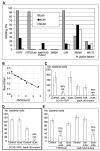Helicobacter pylori SabA adhesin in persistent infection and chronic inflammation
- PMID: 12142529
- PMCID: PMC2570540
- DOI: 10.1126/science.1069076
Helicobacter pylori SabA adhesin in persistent infection and chronic inflammation
Abstract
Helicobacter pylori adherence in the human gastric mucosa involves specific bacterial adhesins and cognate host receptors. Here, we identify sialyl-dimeric-Lewis x glycosphingolipid as a receptor for H. pylori and show that H. pylori infection induced formation of sialyl-Lewis x antigens in gastric epithelium in humans and in a Rhesus monkey. The corresponding sialic acid-binding adhesin (SabA) was isolated with the "retagging" method, and the underlying sabA gene (JHP662/HP0725) was identified. The ability of many H. pylori strains to adhere to sialylated glycoconjugates expressed during chronic inflammation might thus contribute to virulence and the extraordinary chronicity of H. pylori infection.
Figures






References
-
- Cover TL, et al. In: Principles of Bacterial Pathogenesis. Groisman EA, editor. Academic Press; New York: 2001. pp. 509–558.
-
- Gerhard M, et al. In: Helicobacter pylori: Molecular and Cellular Biology. Suerbaum S, Achtman M, editors. Horizon Scientific Press; Norfolk, UK: 2001. chap. 12.
-
- Borén T, et al. Science. 1993;262:1892. - PubMed
-
- Ilver D, et al. Science. 1998;279:373. - PubMed
-
- Hurtig M, Borén T. in preparation.
Publication types
MeSH terms
Substances
Grants and funding
LinkOut - more resources
Full Text Sources
Other Literature Sources
Medical
Molecular Biology Databases

